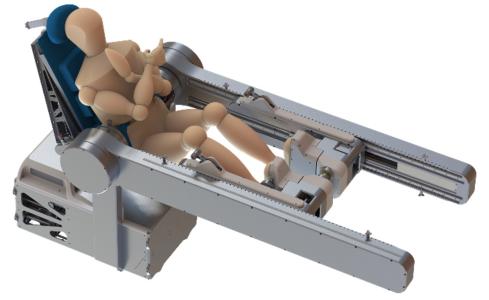AstronauT HeaLtH EnhancemenT Integrated Countermeasure (ATHLETIC)

The objective of the present activity is to obtain a functional and clinically validated prototype of a novel multipurpose astronaut exercise hardware based on exoskeleton technology, compatible with a use in an exploration (transit) vehicle or cislunar station, in a human habitat on the moon or on Mars (reduced gravity) and on the ground (training, rehabilitation).
Future human space exploration, including missions to the Moon and beyond, will require a paradigm shift in the current approach to in-flight exercise countermeasures, particularly when it comes to exercise devices (e.g. CEVIS, T2, ARED to name a few). Exploration vehicles will be significantly smaller, requiring exercise hardware to be smaller, lighter and less complex than current devices, and ideally multi-functional, capable of stressing the musculoskeletal (MSK) system, the cardiovascular (CV) system and other associated system (e.g. neuro-vestibular - NV). Providing sufficient stress to the MSK system within these constraints will be a particular challenge, as the system responds most effectively to high loads (and loading rates for bone), which are achieved through both external loading and impact forces. Effects on the MSK shall also contribute to preserve an acceptable level of afferentation for the neuro-sensory system to preserve astronaut's balance capabilities.The current set of exercise hardware used on ISS, although increasingly effective, is not suitable for the unique constraints of future space explorations vehicles and planetary surface habitats. Considering the above, a number of recent activities have been performed under different ESA programmes to identify new countermeasure / exercise concepts (DYNASUIT - 1 GSP activity; ICS1 ICS2: Integrated Countermeasure Systems ; 4 TRP activities). Such new concepts are 'integrated', which means:- targeting more than one physiological system (e.g. musculoskeletal, neuro-vestibular, cardiovascular)- designed for multipurpose use (training, countermeasure, reconditioning / rehabilitation)- light footprint for use and storageThe activity plans in particular to reuse the outcome of the GSTP activity 'Bone and Muscle Modelling' to assess ex-ante the effectiveness of new countermeasure system, as well as prevent any design choices which could lead to potential injuries. Reuse of conclusions from the'Force-feedback with Immersive Technology Suit (FITS)' study as well as the 'Space Exoskeleton Development (SPOC)' will be sought.While previous activities have led to interesting results and are further tested in BedRest campaigns, the present activity proposes a concept not yet investigated, combining both's expertise and experience acquired in the last years in the fields of countermeasures and robotics. ATHLETIC indeed relies on the development of multipurpose exoskeleton system focusing on the lower limbs (i.e. the most affected by the microgravity environment).The activity includes the following tasks:1. Review of the Scientific and Technical Background in order to consolidate the system requirements. This task includes the assessment of the biofeedback and immersive technologies.2. Safety: transversal task to the project (starting with task 1 and lasting until the end of the project). Task is required to generate the documentation to be submitted while requesting the authorizations to perform the scientific assessment (scientific evaluation) of the prototype.3. Concept (including utilization scenarios), preliminary design and breadboarding4. Detailed design (consolidation of the outcomes of previous task after approval by the Agency)5. Manufacturing, assembly, integration and technical testing6. Scientific validation (clinical validation with trials on a number of subjects to conclude on the system effectiveness)7. Recommendations and conclusions
